|
|
The Timeless Beauty of Dionysus
|
|
He has the perfect features: Gentleness, sensuality, joie de vivre – all of this radiates from the wonderful marble head of Dionysus, which we proudly present as the highlight of the month before the summer starts. The masterly work is of the Horti Lamiani type. The name originates from an ancient luxurious estate on the Esquiline Hill in Rome, where as early as the 16th century magnificent marble statues were found, amongst them the eponymous Dionysus (Bacchus), which is preserved today in the Palazzo dei Conservatori. An artist with the drive for perfection also created the Roman votive hand of a woman. Nails and the bed of nails, palm and thumb base, heart- and headlines – all worked out in detail and realistically. An almost 2,000-year-old masterwork from the famous Moussaieff collection.
|
Save the Date: ART&ANTIQUE Salzburg from 12 August. At the start odf the summer, we dare to take a look ahead: From 12 August we participate as the only gallery for ancient art at the ART&ANTIQUE in the Salzburg Residenz. The art fair, which takes place in parallel to the Salzburger Festspiele is traditionally the highlight in our art year. Look forward to millennia-old beauty that complements every art collection in a unique way.
|
|
P.S.: Until 23 June (inclusive) the galleries in Vienna are open by appointment only. Thank you!
|
|
Die zeitlose Schönheit des Dionysos
|
Er hat die perfekten Züge: Sanftmut, Sinnlichkeit, Lebensfreude – all das strahlt der wundervolle Marmorkopf des Dionysos aus, den wir vor dem Start in den Sommer als Highlight des Monats präsentieren dürfen. Die meisterliche Arbeit zählt zum Typ Horti Lamiani. Der Name entstammt einem luxuriösen Anwesen auf dem Esquilin-Hügel in Rom, wo man schon ab dem 16. Jahrhundert prachtvolle Marmorstatuen fand, darunter den namensgebenden Dionysos (Bacchus), der heute im Palazzo dei Conservatori aufbewahrt wird. Ein Künstler mit Willen zur Perfektion hat auch die römische Votivhand einer Frau geschaffen. Nägel und Nagelbetten, Hand- und Daumenballen, Herz- und Kopflinie – alles ist detailgetreu und lebensecht wiedergegeben. Ein fast 2.000 Jahre altes Meisterwerk aus der berühmten Sammlung Moussaieff.
|
Save the Date: ART&ANTIQUE Salzburg ab 12. August. Zum Start in den Sommer wagen wir auch einen kleinen Blick nach vorne: Ab 12. August nehmen wir wieder als einzige Galerie für Kunst der Antike an der ART&ANTIQUE in der Salzburger Residenz teil. Die Kunstmesse, die parallel zu den Salzbuger Festspielen stattfindet ist traditionell der Höhepunkt in unserem Kunstjahr. Freuen Sie sich auf jahrtausendealte Schönheit, die jede Kunstsammlung auf einzigartige Art bereichert.
|
|
P.S.: Bis einschließlich 23. Juni sind die Galerien in Wien nur auf Vereinbarung geöffnet. Vielen Dank!
|
|
|
|
Our Highlight of the Month:
|
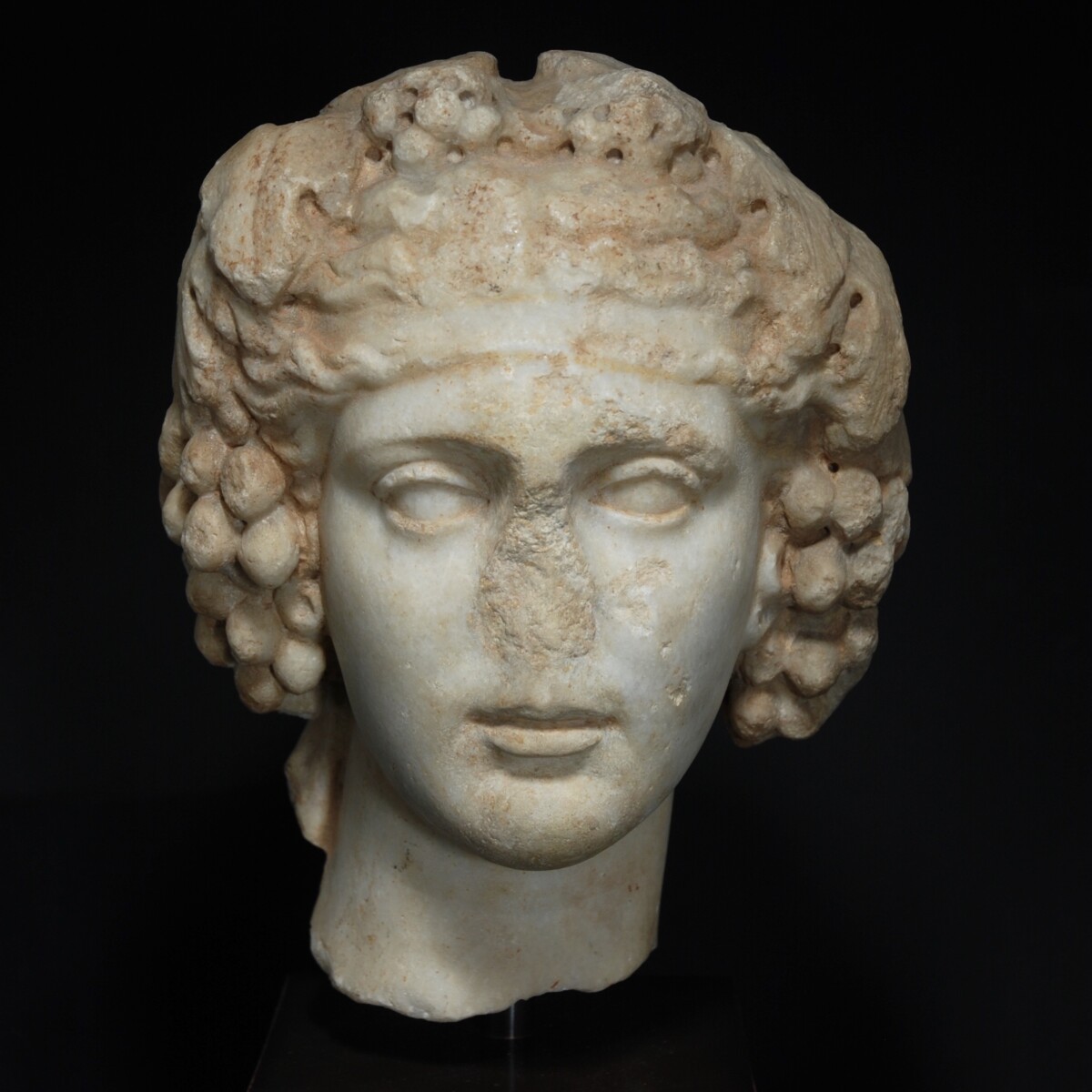
|
|
|
|
|
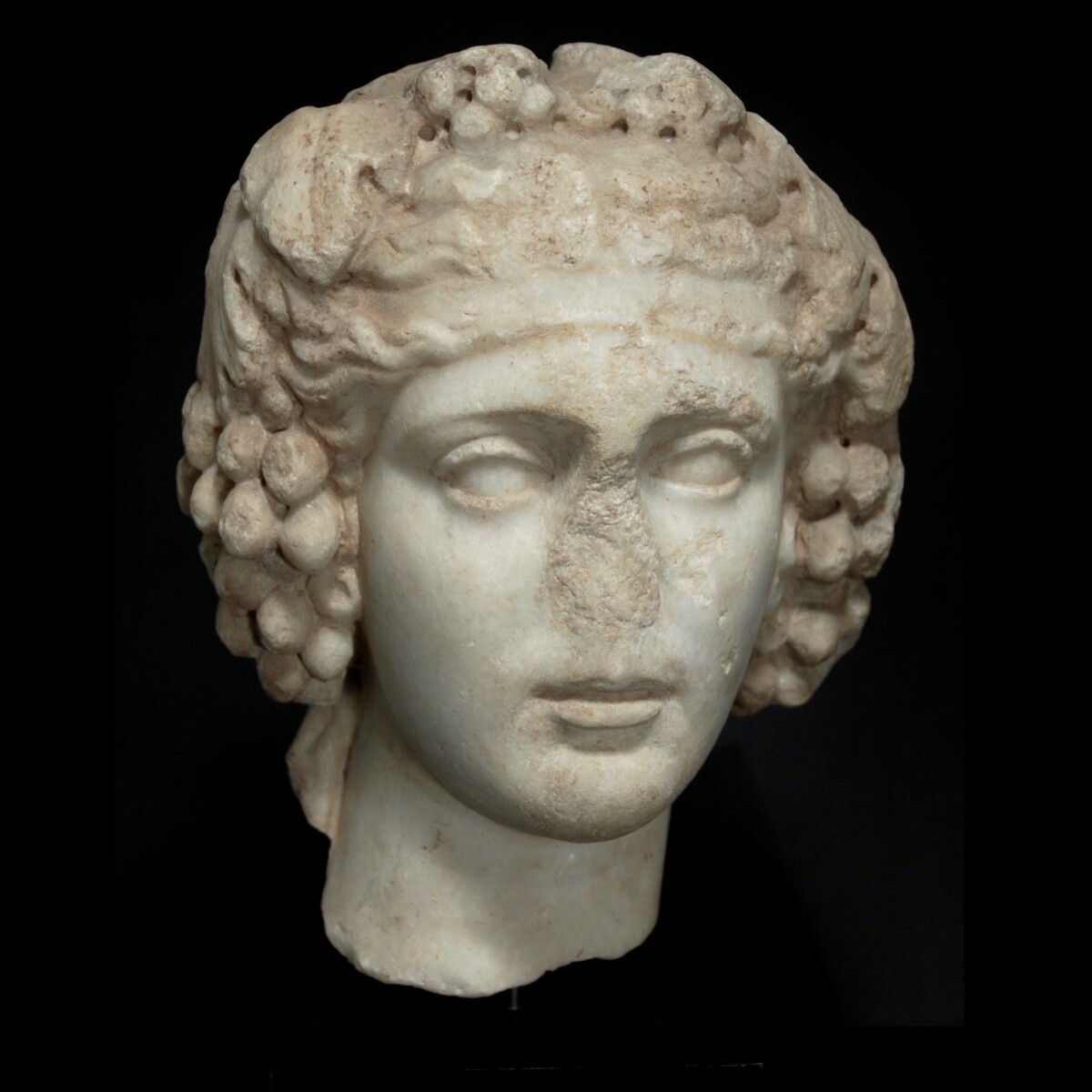
|
|
Roman Empire – 170-190 A.D.
|
Lifesize and very charming marble head of young Dionysus. The god with fine, almost female features looks vigilantly, softly smiling straight ahead. His mouth is slightly open, the eyes sit behind thick lids, cheeks and chin are smooth and well-shaped. His wavy hair is tightly pulled back to a bun. He wears a filet, on top a magnificent headdress of wine- and ivy leaves with grapes and corymbs. On the sides thick bundles of grapes cascade over temples and ears. The youthful Dionysus with a hair wreath of fruits and leaves corresponds to the famous typus “Horti Lamiani”, dating to the Antonine period. The Horti Lamiani was a luxurious estate on the Esquiline Hill in Rome, where as early as the 16th century magnificent marble statues were found, including the eponymous Dionysus (Bacchus), which is now in the Palazzo dei Conservatori. Another head of the same type is in the Capitoline Museum with the inventory number MC 1129. Mounted.
|
Provenance: US collection David F. Hoff (1948-2021), acquired prior to 1997. With a copy of a valuation of the collection dated 10 March 1997 by Gerald Tomlin Antiques, Dallas, which depicts a photo of the head.
Dimensions: 27.3 cm high
Price: 68 000 Euro
|
|
|
Römisches Reich – 170-190 n.Chr.
|
Lebensgroßer und äußerst anmutiger Marmorkopf des jungen Dionysos. Der Gott mit feinen, fast weiblichen Zügen blickt wach, sanft lächelnd geradeaus. Sein Mund ist leicht geöffnet, die Augen sitzen unter dicken Lidern, Wangen und Kinn sind glatt und wohlgeformt. Sein welliges Haar ist straff nach hinten zu einem Knoten gebunden. Er trägt ein Stirnband, über dem ein prachtvoller Kopfschmuck aus Wein- und Efeublättern mit Weintrauben und Korymben. Seitlich fallen dichte Bündel Trauben über Schläfe und Ohren. Der jugendliche Dionysos mit dem Haarkranz aus Früchten und Blättern entspricht dem berühmten Typus „Horti Lamiani“, der in antoninische Zeit datiert. Der Horti Lamiani war ein luxuriöses Anwesen auf dem Esquilin-Hügel in Rom, wo man schon ab dem 16. Jahrhundert prachtvolle Marmorstatuen fand, darunter den namensgebenden Dionysos (Bacchus), der heute im Palazzo die Conservatori aufbewahrt wird. Ein weiterer Kopf des Typus befindet sich im Kapitolinischen Museum mit der Inventarnummer MC 1129. Gesockelt.
|
Provenienz: Amerikanische Sammlung David F. Hoff (1948-2021), erworben vor 1997. Mit einer Kopie einer Sammlungsschätzung vom 10. März 1997 von Gerald Tomlin Antiques, Dallas, die ein Foto des Kopfes zeigt.
Höhe: 27,3 cm
Preis: 68.000 Euro
|
|
|
|
Selected Artworks of the Month:
|
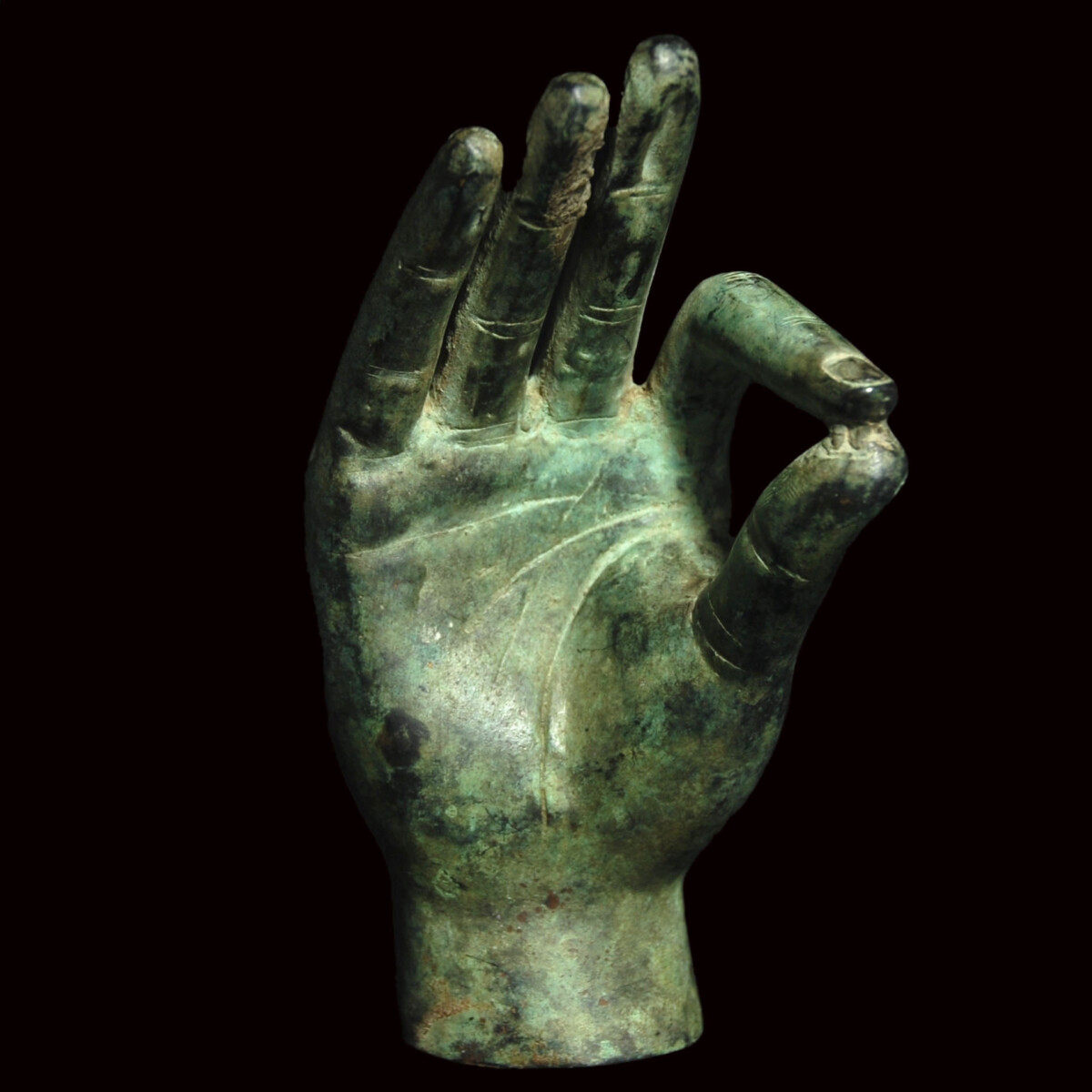
|
|
|
|
|
|
Roman Empire – 1st-2nd century A.D.
|
Extremely fine and realistically worked out right bronze hand of a woman, which served as a votive offering. The thumb and index finger touching each other, the other three fingers are stretched out. The nails are also accentuated in details, so are the palms and the thumb base. The folds on the fingers inside and outside are engraved in cold work. Life, heart and head lines are deeply drawn on the palm. See for the type and hand position the votive hand in the MAH Musée d’art et d’histoire in Geneva with the inventory number AA 2004-0212, as well as Christie’s auction London on 6 October 2011, lot 143.
|
Provenance: Private collection Shlomo Moussaieff (1925-2015), Israel. Acquired between 1948 and 2000.
Dimensions: 15.7 cm long
Price: 10 000 Euro
|
|
|
Römisches Reich – 1.-2. Jahrhundert n. Chr.
|
Überaus fein und lebensecht gearbeitete rechte Bronzehand einer Frau, die als Votivgabe diente. Der Daumen und der Zeigefinger berühren sich, die drei anderen Finger sind gestreckt. Die Nägel sind ebenso detailreich akzentuiert wie der Hand- und Daumenballen. Die Falten an den Fingern innen und außen sind in Kaltarbeit graviert. An der Innenhand sind Lebens-, Herz- und Kopflinie tief gezogen. Vergleiche zu Typus und Handhaltung die Votivhand im MAH Musée d’art et d’histoire in Genf mit der Inventarnummer AA 2004-0212 sowie Christie’s Auktion London vom 6. Oktober 2011, Los 143.
|
Provenienz: Privatsammlung Shlomo Moussaieff (1925-2015), Israel. Erworben zwischen 1948 und 2000.
Höhe: 15,7 cm
Preis: 10.000 Euro
|
|
|
|
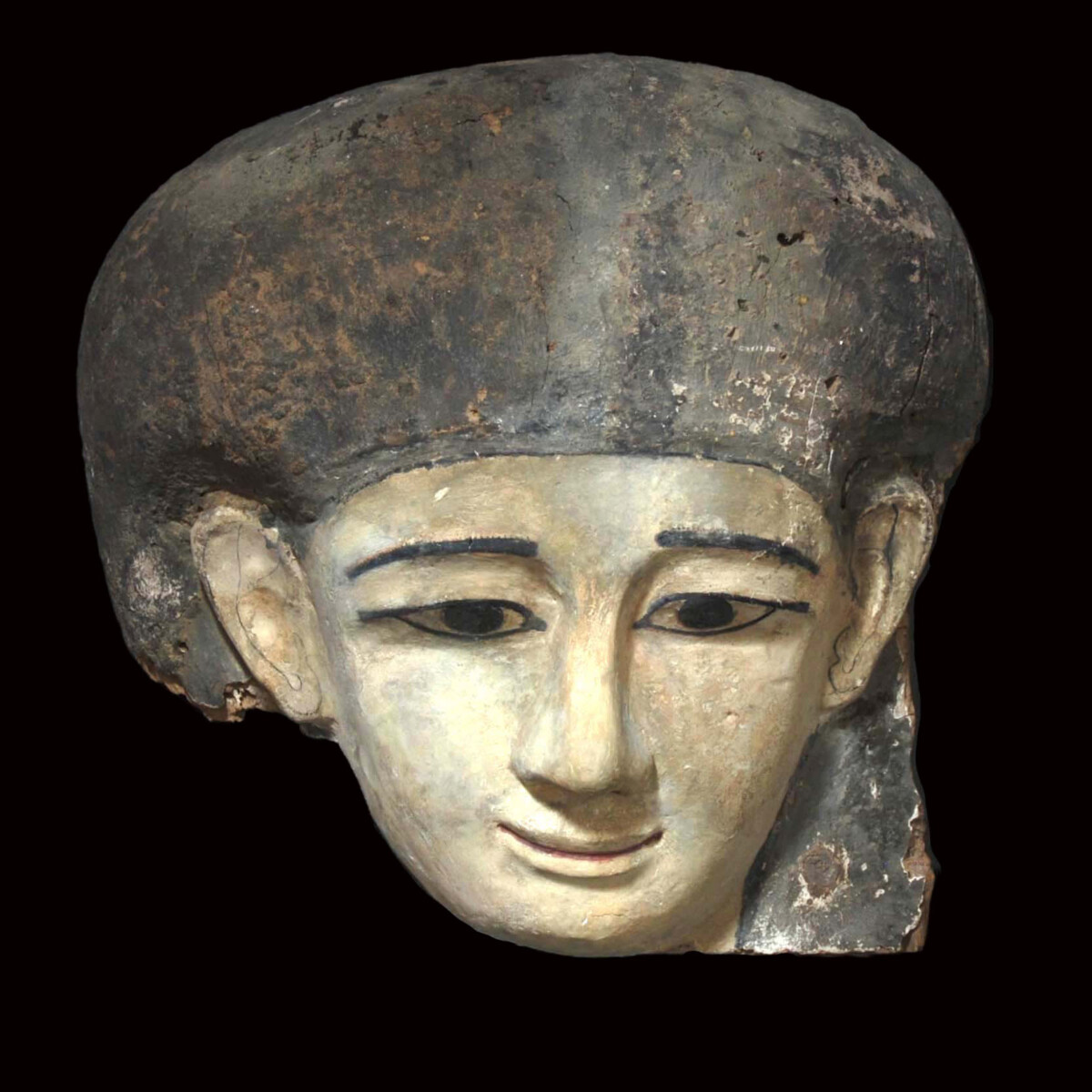
|
|
|
|
Egypt – Late period, 664-332 B.C.
|
Exceedingly sculptural and very large, wood sarcophagus mask with the features of a woman. The finely worked out face with white skin tone is framed by a grey, tripartite wig. The ears are visible. The eyes with a slightly lowered gaze with black pupils, black lids and a short, black eyeliner. The brows also in black with a fine dotted line above. The mouth is formed to a smile, between the lips a fine, red line. A large, very graceful mask. Mounted on a black acryl glass plate for hanging on the wall.
|
Provenance: Private collection Christine Delangle, Paris. Inherited from her parents, who acquired the mask in the 1980s.
Dimensions: 39.8 cm x 38.8 cm
Price: 12 000 Euro
|
|
|
Ägypten – Spätzeit, 664-332 v. Chr.
|
Überaus plastische und sehr große, hölzerne Sarkophagmaske mit den Zügen einer Frau. Das fein gearbeitete Gesicht mit weißem Hautton wird von einer grauen, dreiteiligen Perücke gerahmt. Die Ohren sind frei. Die Augen mit leicht gesenktem Blick mit schwarzen Pupillen, schwarzen Lidern und einem kurzen schwarzen Lidstrich. Die Brauen ebenfalls schwarz mit einer feinen Punktreihe darüber. Der Mund ist zu einem Lächeln geformt, zwischen den Lippen eine feine rote Linie. Eine große, sehr anmutige Maske. Auf einer schwarzen Acrylglasplatte zur Montage an der Wand aufgebracht.
|
Provenienz: Privatsammlung Christine Delangle, Paris. Übernommen von den Eltern, die die Maske in den 1980er Jahren erwarben.
Dimensionen: 39,8 cm x 38,8 cm
Preis: 12.000 Euro
|
|
|
|
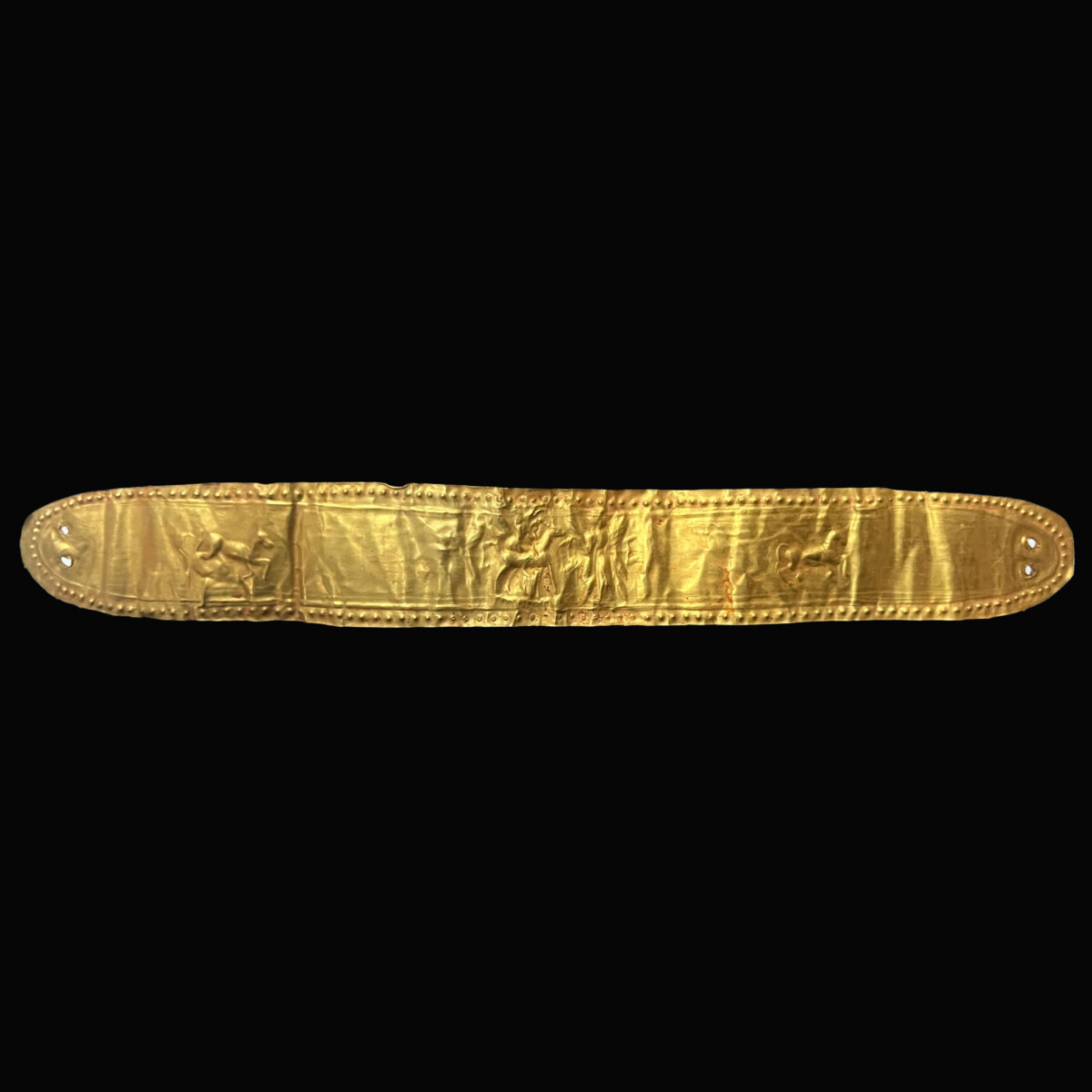
|
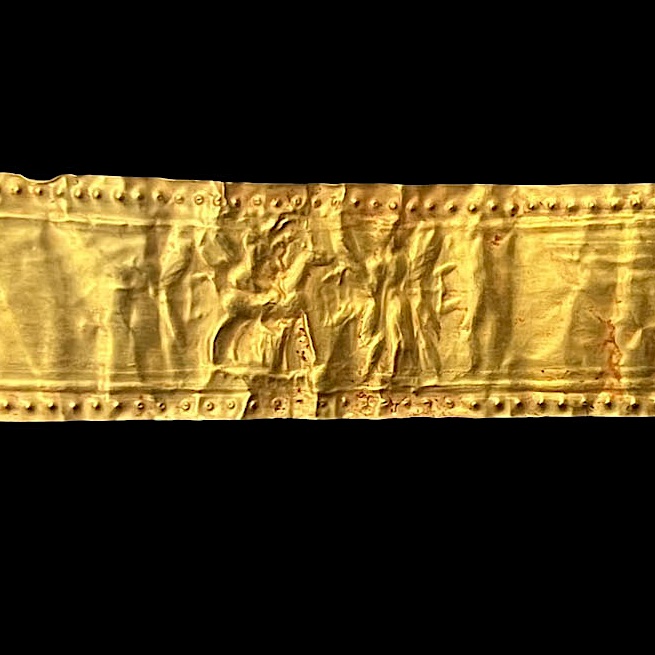
|
|
|
|
Greece – 2nd half of 4th century B.C.
|
Hammered diadem of fine gold sheet with rounded corners. On the edge an encircled punched row of beads. In the centre stands a winged goddess, possibly Nike with a flower and a torch facing to the left. Opposite her a horned animal with a rider. Left and right two galopping horses. The diadem was attached to a helmet or directly to the forehead with ribbons via the perforations at the ends.
|
Provenance: From a New York collection, acquired in the 1990s.
Dimensions: 18.5 cm long
|
|
|
Griechenland – 2. Hälfte 4. Jahrhundert v. Chr.
|
Gehämmertes Diadem aus feinem Goldblech mit abgerundeten Enden. Am Rand umlaufend ein punziertes Perlenband. Im Zentrum steht eine geflügelte Göttin, wohl Nike mit Blume und Fackel nach links blickend. Ihr gegenüber ein gehörntes Tier mit Reiter. Links und rechts zwei galoppierende Pferde. Über die Lochungen an den Enden wurde das Diadem auf einem Helm oder mit Bändern direkt an der Stirn montiert.
|
Provenienz: Aus New Yorker Sammlung, erworben in den 1990er Jahren.
Länge: 18,5 cm
Preis: 2.800 Euro
|
|
|
|
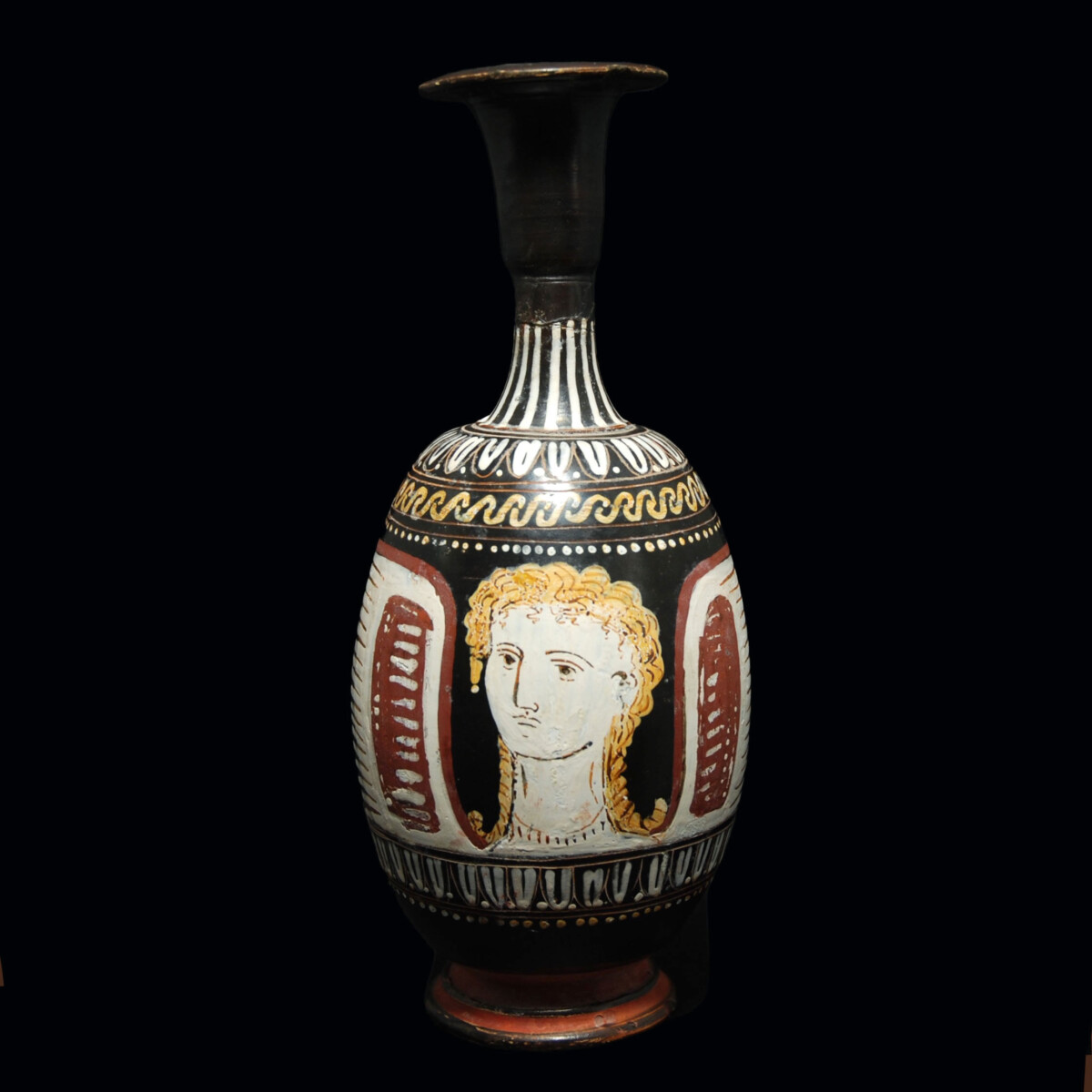
|
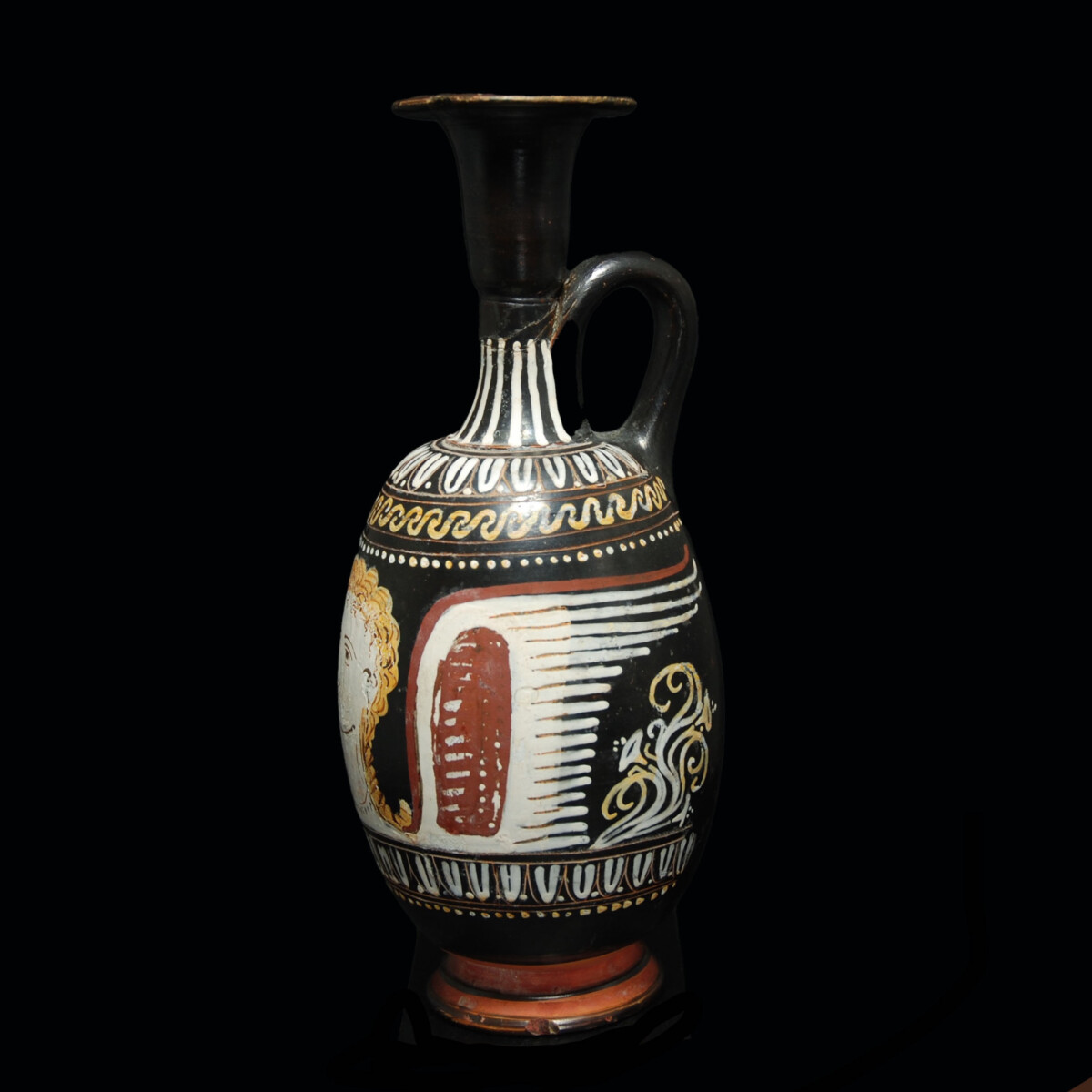
|
|
Greece/Gnathia – 340-325 B.C.
|
Finely worked out lekythos with paint in white, red and yellow. The image area depicts a painted woman’s portrait in high quality between two wings. The woman, possibly the goddess Nike is depicted in three-quarter view, her head slightly raised and facing to the left. Her blond hair is thick and untamed, on the sides two long strands cascade to the shoulders, the ends rolled in. Her gaze is melancholic, the mouth closed. The woman wears a necklace. The wonderful portrait originates from the “Painter of the Louvre Bottle”. The reference vase in the Louvre with the collection number Cp3427 also depicts Nike in three-quarter view. Her hair is slightly tousled, eye area and necklace are almost identical. The wings on the present lekythos are red with plumes applied in thick opaque white. They possibly originate from the “Painter from Lecce 1075” who was the teacher of the “Painter of the Louvre Bottle”. See as reference the lekythos in the Museum für Kunst und Gewerbe Hamburg with the inventory number 1917.1044, which also is a collaborative work of both masters. The wings on the Hamburg vase are, like on the present lekythos red with white dots, the plumes fade into white-yellow, typical for the “Painter from Lecce 1075”. Except from the woman’s portrait the lekythos is abundantly decorated, the neck with ray décor, the shoulder with tongues and wavy band, below dots. The end of the image area is formed by tongues with dotted decoration. Below the wings white yellow tendrils. The lekythos has a horizontal, far protruding rim. The ring foot is finely profiled.
|
Provenance: Viennese private collection Ernst Degasperi (1927-2011), acquired in the 1960s to 1970s. Since then in the family estate.
Dimensions: 19.3 cm high
|
|
|
Griechenland/Gnathia – 340-325 v. Chr.
|
Fein gearbeitete Lekythos mit Bemalung in Weiß, Rot und Gelb. Die Bildfläche zeigt ein hochwertig gemaltes Frauenporträt zwischen zwei Flügeln. Die Frau, möglicherweise die Göttin Nike, ist in Dreiviertel-Ansicht dargestellt, sie hat den Kopf leicht angehoben und blickt nach links. Ihre blonden Haare sind dicht und ungeordnet, seitlich fallen zwei lange Strähnen auf die Schultern, die Enden eingedreht. Ihr Blick ist melancholisch, der Mund geschlossen. Die Frau trägt eine Halskette. Das wunderbare Porträt stammt aus der Hand „des Malers der Louvre Flasche“. Die Referenzvase im Louvre mit der Sammlungsnummer Cp 3427 zeigt ebenfalls Nike in Dreiviertel-Ansicht. Ihr Haar ist leicht zerzaust, Augenpartie und Halskette sind nahezu ident. Die Flügel auf unserer Lekythos sind rot mit Federn in dickem Deckweiß aufgetragen. Sie stammen wohl vom „Maler von Lecce 1075“, der als Lehrer des „Malers der Louvre Flasche“ gilt. Vergleiche dazu die Lekythos im Museum für Kunst und Gewerbe Hamburg mit der Inventarnummer 1917.1044, die ebenfalls ein gemeinsames Werk beider Meister ist. Die Flügel auf der Hamburger Vase sind wie auf unserer Lekythos rot mit weißen Tupfen, die Federn laufen weißgelb aus, typisch für den „Maler von Lecce 1075“. Abgesehen vom Frauenporträt ist die Lekythos üppig dekoriert, der Hals mit Strahlendekor, die Schulter mit Zungen und Wellenband, darunter Punkte. Den Abschluss unter der Bildfläche bildet wieder Zungen mit Punktdekor. Unter den Flügeln weißgelbe Ranken. Die Lekythos hat einen horizontalen, weit nach außen gezogenen Rand. Der Ringfuß ist fein profiliert.
|
Provenienz: Wiener Privatsammlung Ernst Degasperi (1927-2011), erworben in den 1960er bis 1970er Jahren. Seitdem in Familienbesitz.
Höhe: 19,3 cm
Preis: 3.000 Euro
|
|
|
|
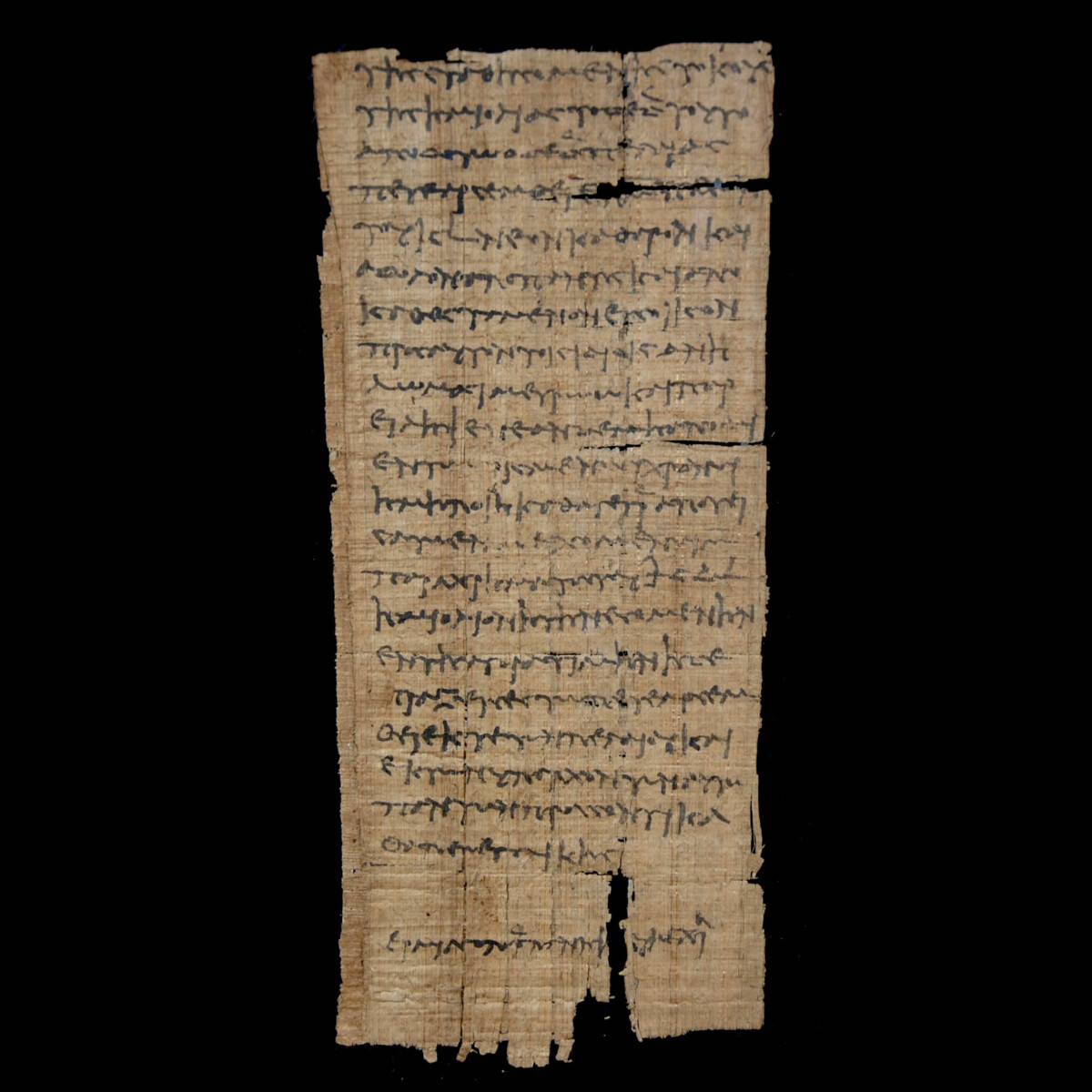
|
|
Egypt – Ptolemaic period, 100 B.C.
|
Beautifully preserved, one-sided inscribed papyrus dating to the Ptolemaic period. 22 preserved lines (above around eight lines are missing) mention a grain loan of a man named Peteharsemtheus. The loan is certified by Hermias, assistant to Paniskos, in Gebelein. Hermias and Paniskos were officials in the local Grapheion. They are known from numerous other papyri, especially from the so-called Horus archive. This ancient family archive of the mercenary Horus, son of Nechoutes, consists of over 50 documents, which were acquired by the English private collection of Lord Elkan Nathan Adler in 1924. These are mainly loans, sales contracts and other legal texts. The present papyrus indicate clear connections to the Horus archive and could have originally been a part of it. On 14 May 1997 the papyrus was subject of a lecture at the Institute of Papyrology at Sorbonne in Paris, held by Hélène Cadell. Framed behind two plexiglasses.
|
Provenance: From a German private collection, acquired in the 1980s. With a copy of the seminar series 1996-1997 at the Sorbonne in Paris, which mentions the lecture about the papyrus held by Hélène Cadell.
Dimensions: 20 cm x 9 cm (papyrus); 25.1 cm x 15 cm (frame)
Price: 2 600 Euro
|
|
|
Ägypten – Ptolemäische Zeit, 100 v. Chr.
|
Schön erhaltener, einseitig beschriebener Papyrus aus ptolemäischer Zeit. Die 22 erhaltenen Zeilen (oben fehlen etwa acht Zeilen) erwähnen ein Getreidedarlehen eines Mannes mit dem Namen Peteharsemtheus. Das Darlehen wird von Hermias, dem Assistenten des Paniskos, in Gebelein beglaubigt. Hermias und Paniskos waren Beamte im örtlichen Grapheion. Sie sind aus zahlreichen anderen Papyrii bekannt, vor allem aus dem sogenannten Horus-Archiv. Dieses antike Familienarchiv des Söldners Horus, Sohn des Nechoutes, enthält über 50 Schriftstücke, die 1924 in die englische Privatsammlung von Lord Elkan Nathan Adler kamen. Es handelt sich vor allem um Darlehen, Kaufverträge und andere juristische Texte. Unser Papyrus weist deutliche Verbindungen zum Horus-Archiv auf und könnte ursprünglich ein Teil davon gewesen sein. Der Papyrus war am 14. Mai 1997 Gegenstand eines Vortrages am Institut für Papyrologie an der Sorbonne in Paris, der von Hélène Cadell gehalten wurde. Gerahmt hinter zwei Plexiglasscheiben.
|
Provenienz: Aus deutscher Privatsammlung, erworben in den 1980er Jahren. Mit einer Kopie der Seminarreihe 1996-1997 von der Sorbonne in Paris, der den Vortrag von Hélène Cadell über den Papyrus erwähnt.
Dimensionen Papyrus: 20 cm x 9 cm; Dimensionen Rahmen: 25,1 cm x 15 cm
Preis: 2.600 Euro
|
|
|
|
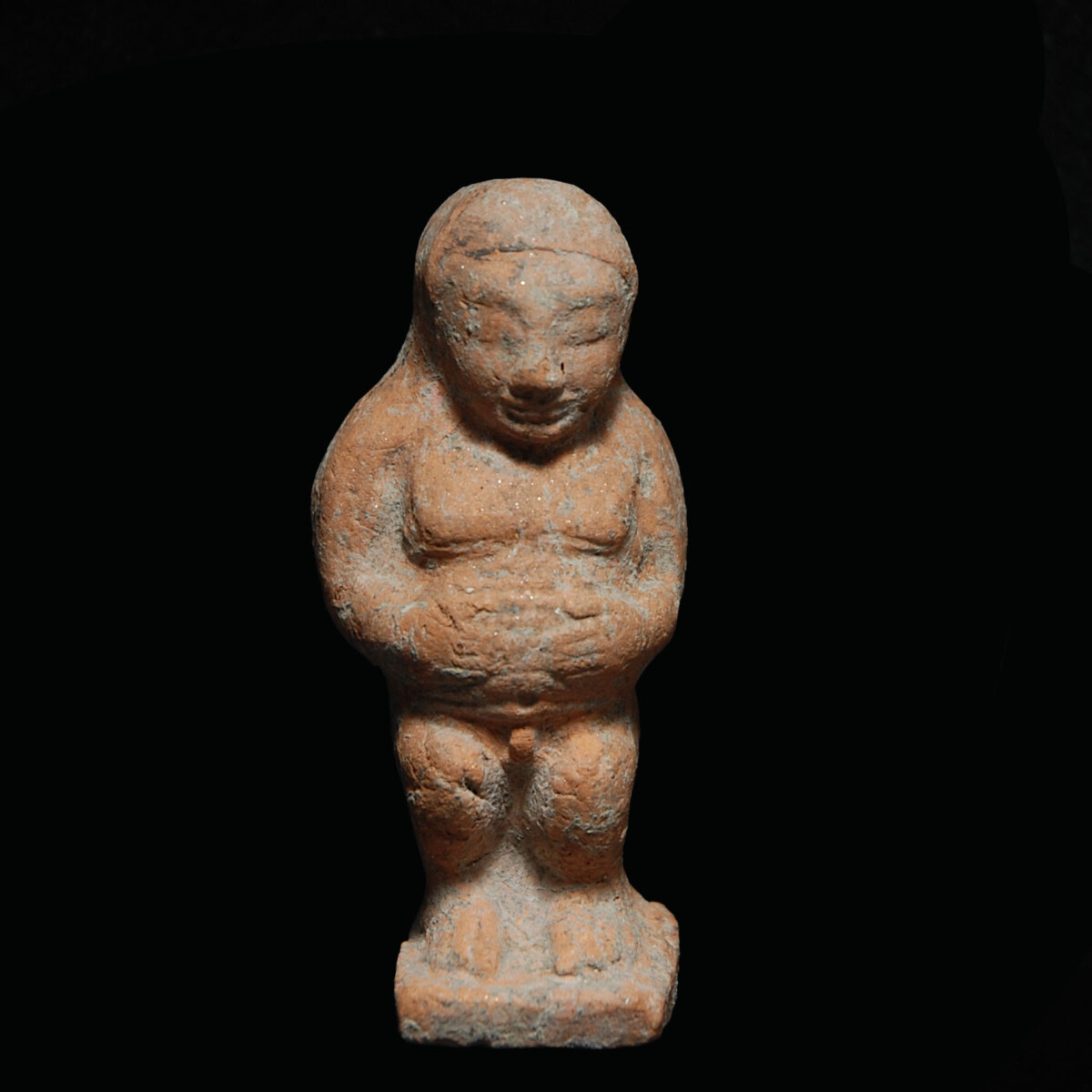
|
|
|
|
|
|
Greece – Late 6th century B.C.
|
Terracotta statuette made of two forms of a dwarf-like, crouching deity (“Pataikos”) with archaic features. The unclothed god stands on a rectangular plinth, he has his hands placed on the fat belly, the round rear far protruding to the back. The face with the typical almond-shaped eyes, the hair long with horizontal curls in style of Greek kouroi. The short legs are bent. The statuette is a local interpretation of the Egyptian god Ptah who was welcomed in the 6th century into the Cypriot and Greek Pantheon. He was awarded abilities of healing and medicine. See for the type of statuettes from Samos and Rhodes in the British Museum with the registration number 1886,0401.1441, as well as 1842,0728.754. Also, in: F. W. Hamdorf „Die figürlichen Terrakotten der Staatlichen Antikensammlung München I“, München 2014, Nr. C40.
|
Provenance: German collection Schlauf-Lensing prior to 1980. Thence with Antikenkabinett Gackstätter with the inventory number 12273. In a Munich collection since 2005. With the original certificate of Antikenkabinett Gackstätter.
Dimensions: 7.3 cm high
Price: 1 600 Euro
|
|
|
Griechenland – Ende 6. Jahrhundert v. Chr.
|
Aus zwei Formen gearbeitete Terrakotta-Statuette einer zwergenhaften, hockenden Gottheit („Pataikos“) mit archaischen Zügen. Der unbekleidete Gott steht auf einer rechteckigen Plinthe, er hat die Hände auf den dicken Wanst gelegt, das runde Gesäß steht hinten weit ab. Das Gesicht mit den typisch mandelförmigen Augen, das Haar lang mit horizontalen Locken im Stil der griechischen Kouroi. Die kurzen Beine sind abgewinkelt. Es handelt sich hier um eine lokale Interpretation des ägyptischen Gottes Ptah, der im 6. Jahrhundert Aufnahme im zypriotischen und griechischen Pantheon fand. Es wurden ihm die Fähigkeiten der Heilung und Medizin zugesprochen. Vergleiche zum Typus die Statuetten aus Samos und Rhodos im British Museum mit der Registration Number 1886,0401.1441 sowie 1842,0728.754. Weiters in: F. W. Hamdorf „Die figürlichen Terrakotten der Staatlichen Antikensammlung München I“, München 2014, Nr. C40.
|
Provenienz: Deutsche Sammlung Schlauf-Lensing vor 1980. Danach Antikenkabinett Gackstätter mit der Inventarnummer 12273. Seit vor 2005 in einer Münchner Sammlung. Mit Original-Zertifikat des Anikenkabinetts Gackstätter.
Höhe: 7,3 cm
Preis: 1.600 Euro
|
|
|
|

|
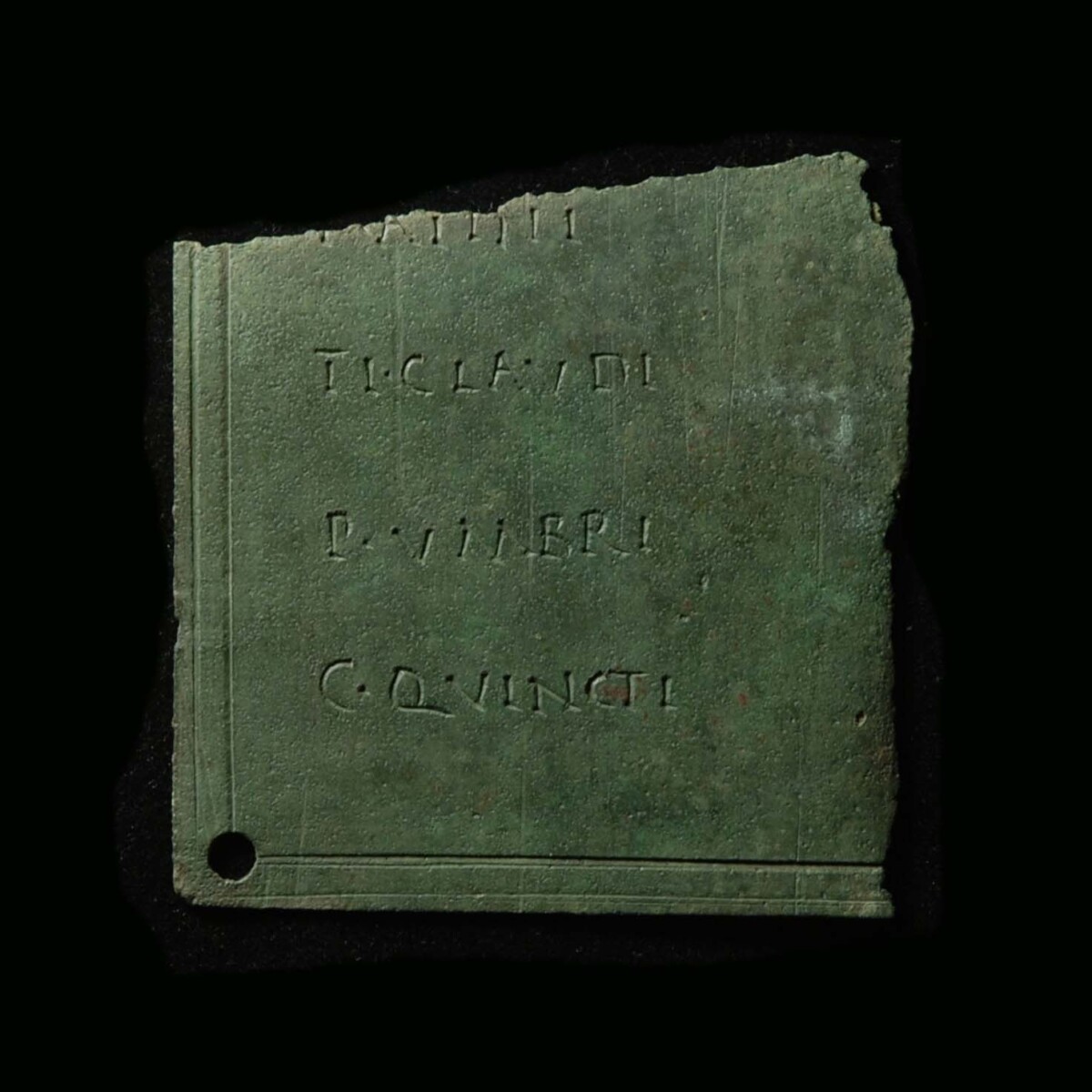
|
|
Roman Empire – 118-119 A.D.
|
Fragment of a military diploma of an auxiliary unit dating to the period of Emperor Hadrian. Preserved is the left lower corner of Tabella II. The diploma originates from a constitution for Moesia Inferior from 118 or 119. The owner was a member of Ala 1 Vespasiana Dardanorum, which was under P. Baebius' command. Published in: P. Holder "Roman Military Diplomas V" (2006), p. 747, no. 349. As well as in: Werner Eck, Peter Weiß "Chiron 32", 2002, p. 453-457.
|
Provenance: From the German collection Peter Weiß, acquired between 1967 and 2015.
Dimensions: 7.5 cm x 6.7 cm
Price: 1 800 Euro
|
|
|
Römisches Reich – 118-119 n. Chr.
|
Fragment eines Militärdiploms einer Auxiliareinheit aus der Zeit des Kaisers Hadrian. Erhalten ist die linke untere Ecke der Tabella II. Das Diplom stammt aus einer Konstitution für Moesia inferior aus dem Jahr 118 oder 119. Der Besitzer war Angehöriger der Ala 1 Vespasiana Dardanorum, die von P. Baebius kommandiert wurde. Publiziert in: P. Holder „Roman Military Diplomas V (2006), S. 747, Nr. 349. Sowie in: Werner Eck, Peter Weiß „Chiron 32“, 2002, S. 453-457.
|
Provenienz: Aus der deutschen Sammlung Peter Weiß, erworben zwischen 1967 und 2015.
Dimensionen: 7,5 cm x 6,7 cm
Preis: 1.800 Euro
|
|
|
|
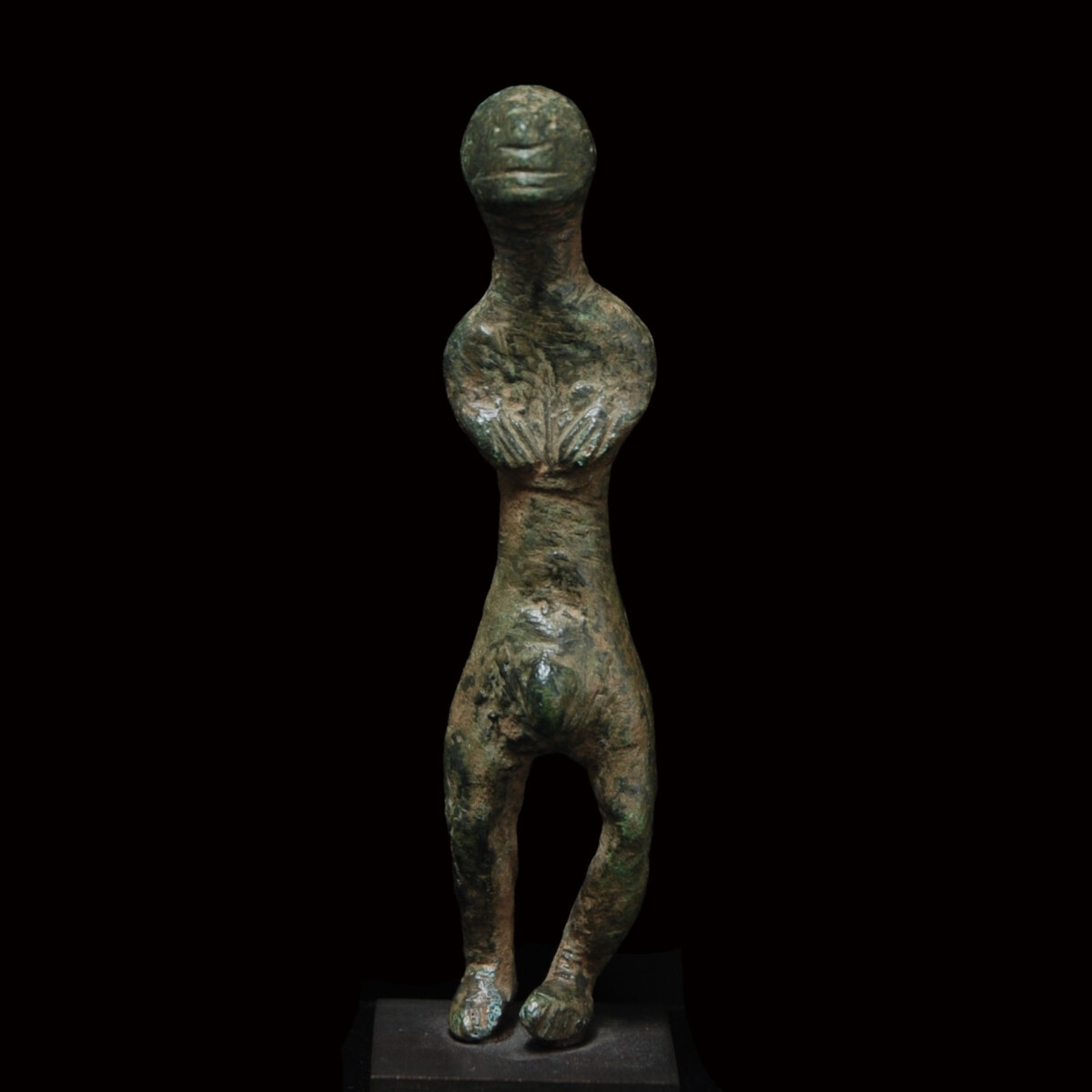
|
|
|
|
|
|
Umbria – 4th century B.C.
|
Solid bronze idol of a stylized, ithyphallic man. The figure with strong, slightly spread legs, an overlong upper body and short, stubby arms, which rest on the chest. The fingers of the hands are accentuated. The private part is also oversized. The head with a pointed face and round back of the head. The eyes are pierced, the mouth formed to a smile. A very expressive fertility idol from central Italy. Mounted.
|
Provenance: From a Munich collection of bronze idols. Acquired in the 1990s to the early 2000s.
Dimensions: 9.2 cm high
Price: 1 600 Euro
|
|
|
Umbrien – 4. Jahrhundert v. Chr.
|
Vollbronze-Idol eines stilisierten, ithyphallischen Mannes. Die Figur mit kräftigen, leicht gespreizten Beinen, einem überlangen Oberkörper und kurzen, stummeligen Armen, die auf der Brust aufliegen. Die Finger an der Hand akzentuiert. Das Geschlecht ebenfalls übergroß. Der Kopf mit spitz zulaufendem Gesicht und rundem Hinterkopf. Die Augen sind nur eingestochen, der Mund zu einem breiten Lächeln geformt. Ein besonders expressives Fruchtbarkeitsidol aus Mittelitalien. Gesockelt.
|
Provenienz: Aus einer Münchner Sammlung von Bronze-Idolen. Erworben in den 1990er bis frühen 2000er Jahre.
Höhe: 9,2 cm
Preis: 1.600 Euro
|
|
|
|
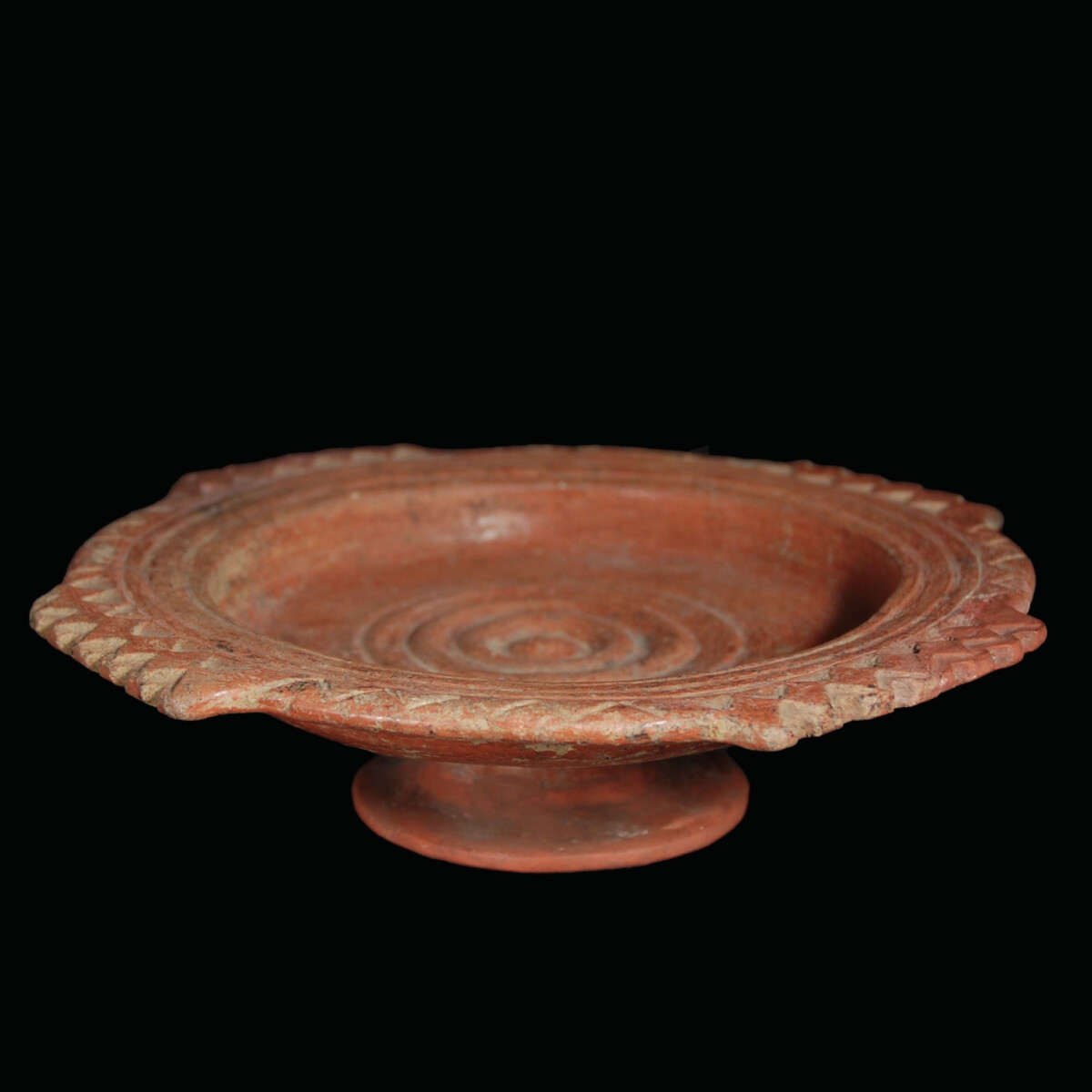
|
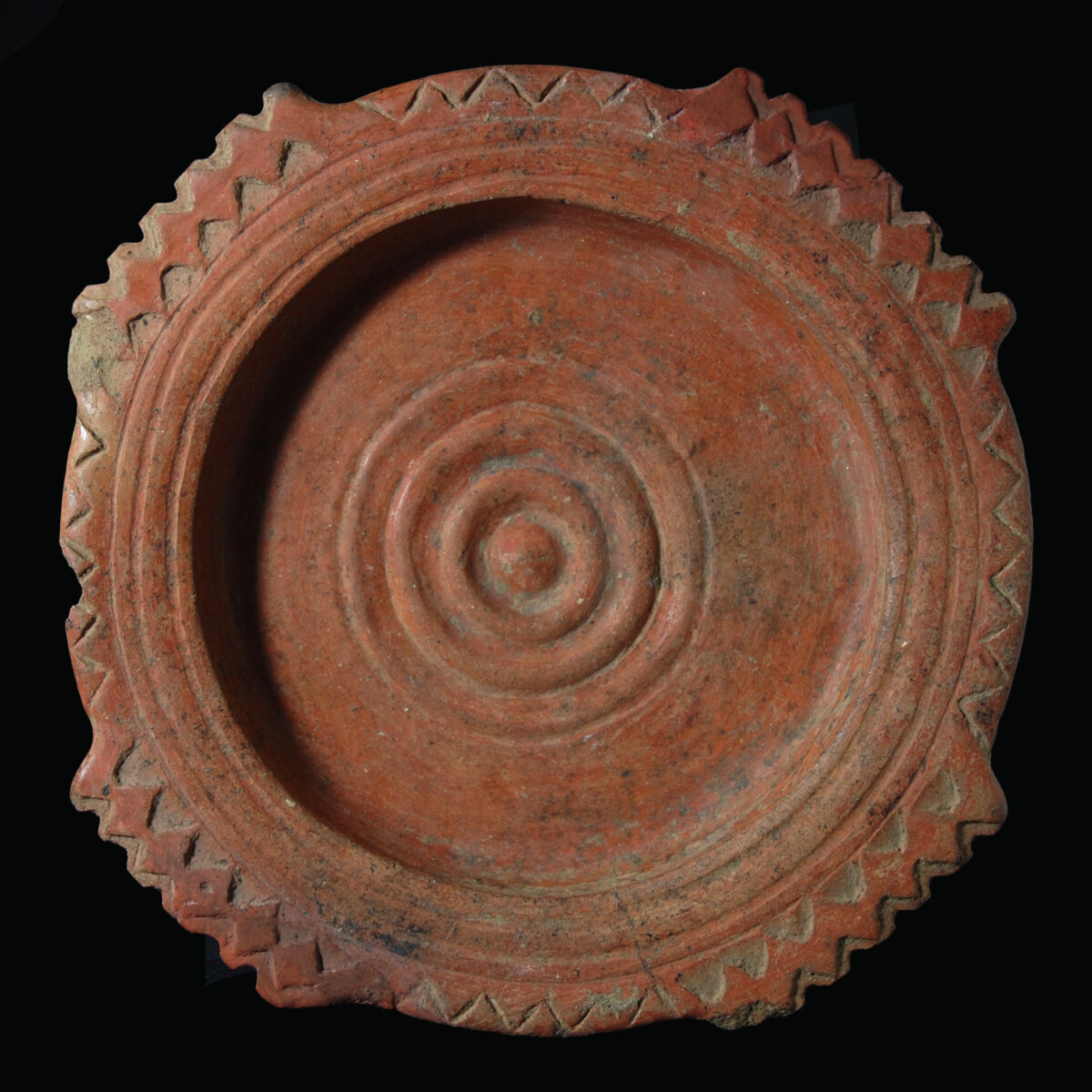
|
|
|
|
Etruria – 7th century B.C.
|
Large Etruscan dish of the so-called Red Ware on a high, far protruding foot ring. The inside is decorated with deeply ribbed, concentric circles. The wall is steep and merges into an abundantly decorated rim. Three finely drawn, encircling indentations followed by engraved zig-zag decoration. In same intervals four jagged handle spaces form the finales. The rare dish belongs to the early phase of orientalisation of Etruscan ceramics. See the cup with foot ring (Accession Number 96.18.140), as well as the plate (Accession Number 96.18.133) in the Metropolitan Museum of Art in New York.
|
Provenance: Private collection Michael Ratzenböck, Upper Austria. For at least 30 years in the family estate.
Dimensions: 21.5 cm in diameter
Price: 1 800 Euro
|
|
|
Etrurien – 7. Jahrhundert v. Chr.
|
Große etruskische Schale der sogenannten Red Ware auf hohem, weit ausladendem Standfuß. Das Innere ist mit tief gerippten, konzentrischen Kreisen verziert. Die Wandung setzt steil an und geht dann in einen reich verzierten Rand über. Drei fein gezogene, umlaufende Vertiefungen bilden den Anfang, daran anschließend graviertes Zickzack-Dekor. In gleichen Abständen bilden vier gezackte Griffflächen den Abschluss. Das seltene Gefäß zählt zur ersten Orientalisierungsphase der etruskischen Keramik. Vergleiche dazu etwa die Fußschale (Accession Number 96.18.140) sowie den Teller (Accession Number 96.18.133) im Metropolitan Museum of Art in New York.
|
Provenienz: Privatsammlung Michael Ratzenböck, Oberösterreich. Seit zumindest 30 Jahren in Familienbesitz.
Durchmesser: 21,5 cm
Preis: 1.800 Euro
|
|
|
|
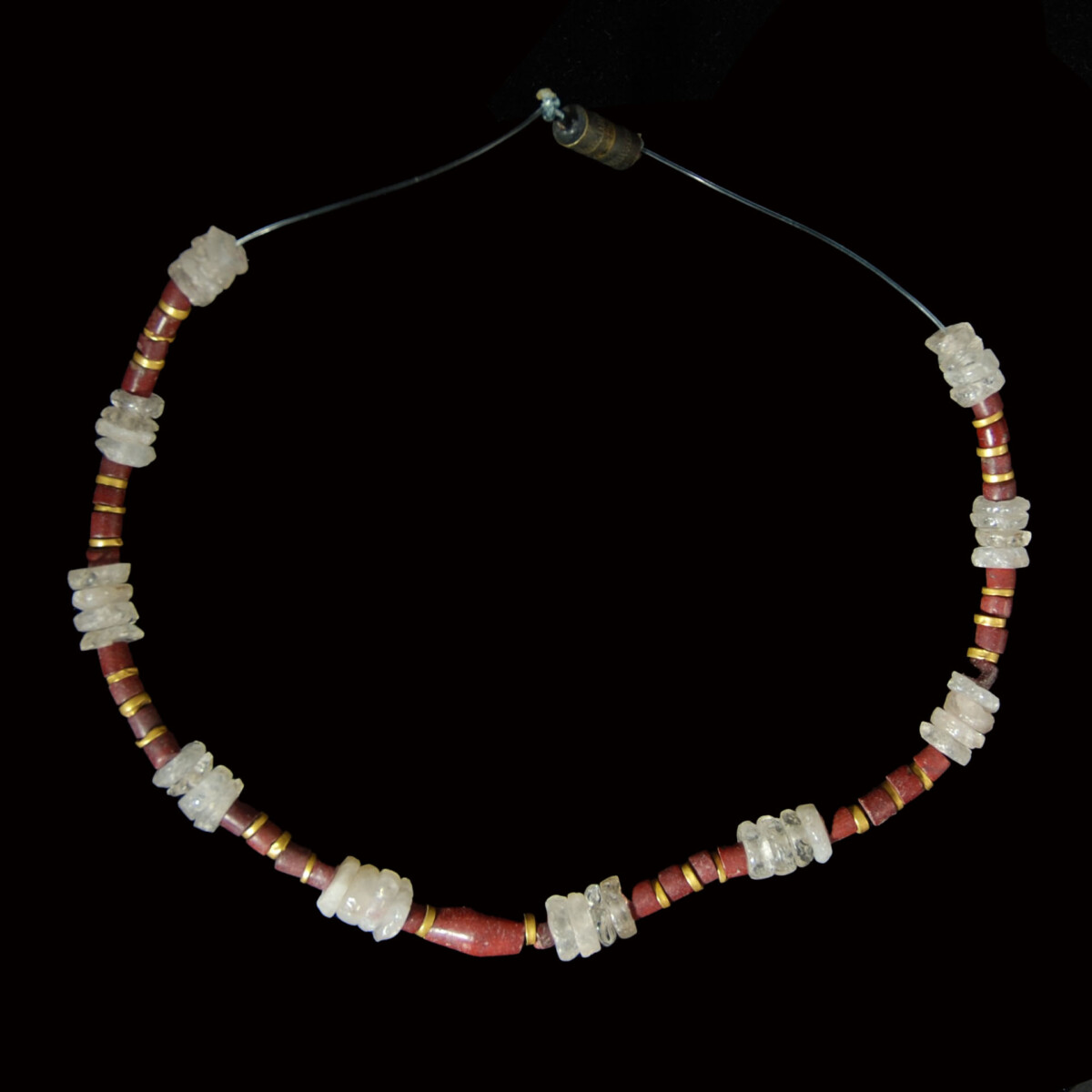
|
|
|
|
Roman Empire – 2nd-3rd century A.D.
|
Ensemble of belonging beads from an imperial necklace. Four ring-shaped rock crystal beads are followed by carnelian beads with fine gold discs in between. In the centre a large, biconical carnelian bead. The ensemble is modern strung on a plastic cord with a clasp. A rethreading to wear the ancient jewellery as a bracelet is recommended.
|
Provenance: Collection Karawani, Paris, acquired in the 1970s. Since then in a family estate.
Dimensions: v
Price: 680 Euro
|
|
|
Römisches Reich – 2.-3. Jahrhundert n. Chr.
|
Ensemble von zusammengehörigen Perlen einer kaiserzeitlichen Halskette. Auf jeweils vier ringförmige Bergkristallperlen folgen Karneolperlen mit feinen Goldscheiben dazwischen. In der Mitte eine große, bikonische Karneolperle. Das Ensemble ist auf einer Plastikschnur mit Verschluss modern gefädelt. Eine Neufädelung, um den antiken Schmuck als Armband zu tragen, wäre anzuraten.
|
Provenienz: Sammlung Karawani, Paris, erworben in den 1970er Jahren. Seitdem in Familienbesitz.
Länge Perlenschmuck: 22,3 cm; Gewicht: 12,3 Gramm
Preis: 680 Euro
|
|
|
|
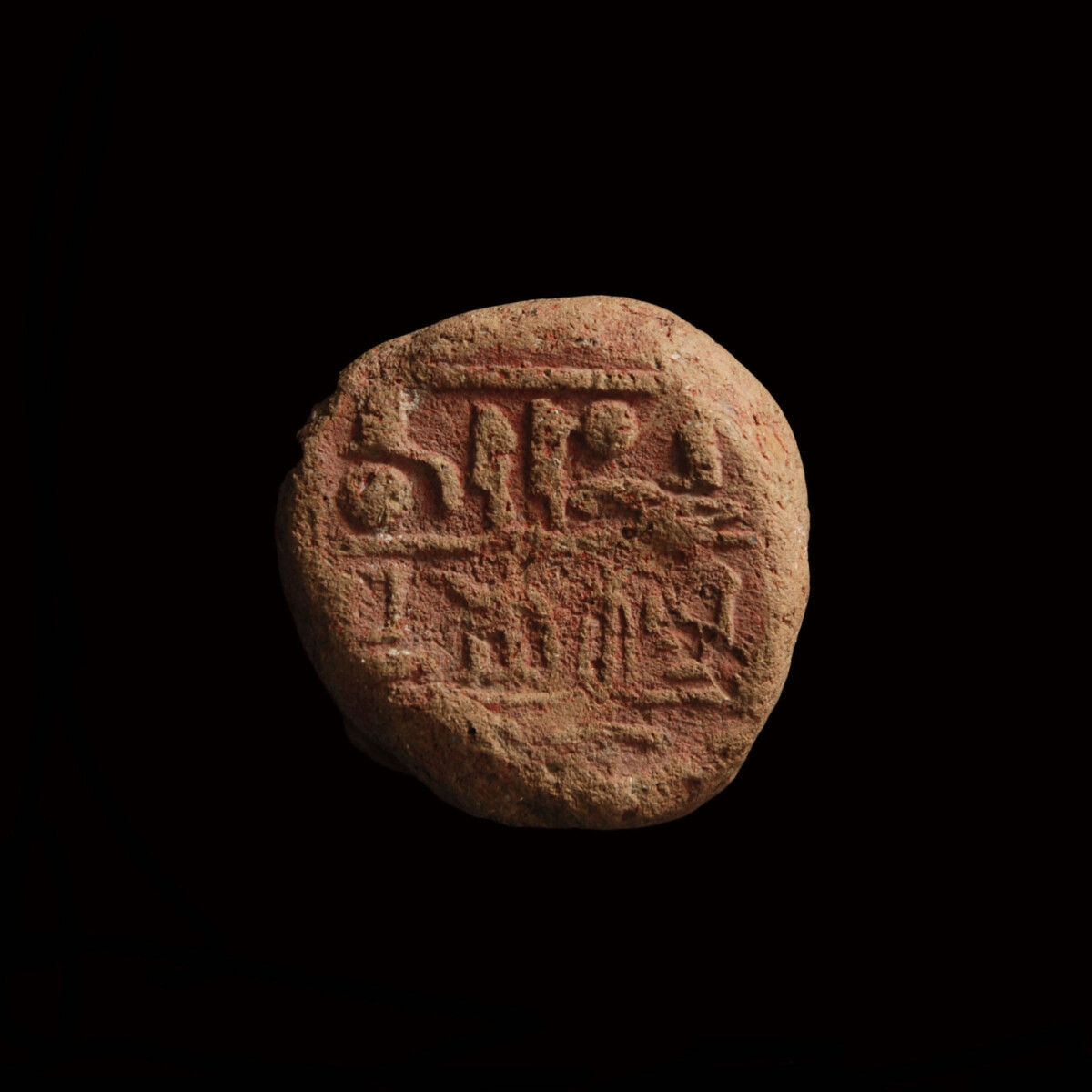
|
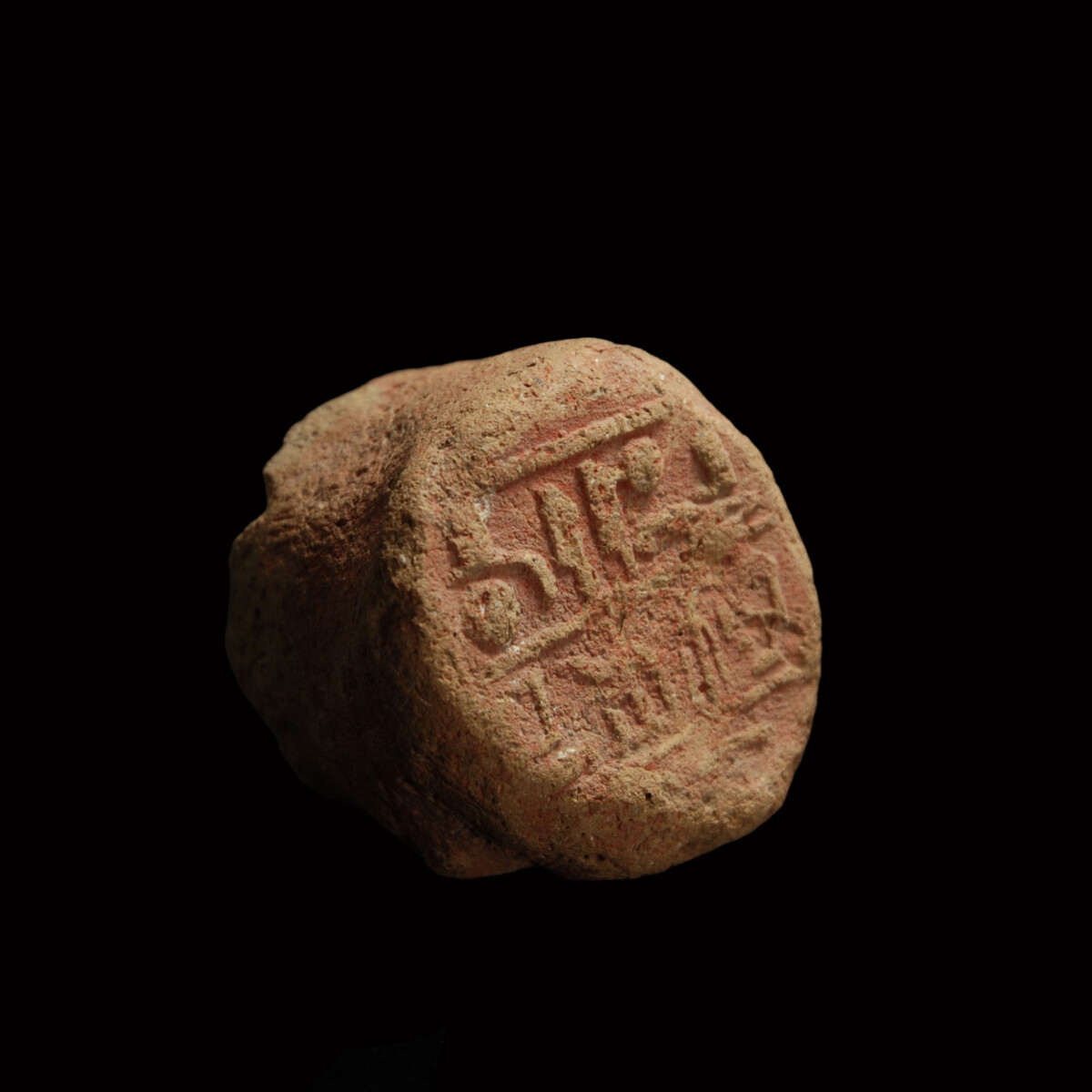
|
|
Egypt – New Kingdom, late 18th or 19th dynasty, 1330-1189 B.C.
|
Terracotta cone from the tomb of the chief Wab priest Sebekmose, which was discovered around 1918. The tomb is located in Thebes West in the necropolis Qurnet Murai and has the number TT275. Sebekmose must have been an important person. His name means “The Crocodile God”. The cone depicts on its flat side a hieroglyphic inscription in three registers which are separated by horizontal lines. The inscription reads: “The revered one before Osiris, the head Wab-priest Sebekmose, justified.” The duties of Wab priests were to bring offerings, music instruments and holy cult objects to the altar or shrine and to clean them. They lived chaste, bathed twice a day and twice at night, and were shaved from head to foot. Overall, around 300 funerary cones were found in Sebekmose’s tomb, most of them only fragmentarily preserved. They are published in the standard work about funerary cones “A Corpus of Inscribed Egyptian Funerary Cones” by Norman de Garis Davies and Miles Frederick Laming Macadam, Oxford 1957 as number 501.
|
Provenance: Viennese private collection Ernst Degasperi (1927-2011), acquired in the 1960s to 1970s. Thence in the family estate.
Dimensions: 7 cm x 6.7 cm
Price: 900 Euro
|
|
|
Ägypten – Neues Reich, späte 18. oder 19. Dynastie, 1330 -1189 v. Chr.
|
Terrakotta-Kegel aus dem Grab des obersten Wab-Priesters Sebekmose, das etwa um 1918 entdeckt wurde. Das Grab liegt in Theben West in der Nekropole Qurnet Murai und hat die Nummer TT275. Sebekmose muss ein bedeutender Mann gewesen sein. Sein Name bedeutet „der Krokodil-Gott“. Der Kegel weist auf seiner flachen Seite eine Hieroglypheninschrift in drei Registern auf, die durch horizontale Linien getrennt sind. Die Inschrift lautet: „Der Ehrwürdige vor Osiris, der oberste Wab-Priester Sebekmose, der Gerechtfertigte.“ Wab-Priester hatten die Aufgabe, Opfergaben, Musikinstrumente und heilige Kultobjekte zum Altar oder Schrein zu bringen und zu reinigen. Sie leben keusch, badeten zweimal am Tag und zweimal nachts und waren von Kopf bis Fuß rasiert. Insgesamt wurden in Sebekmoses Grab rund 300 Grabkegel gefunden, von denen die meisten nur fragmentarisch erhalten sind. Sie sind im Standardwerk über Grabkegel „A Corpus of Inscribed Egyptian Funerary Cones“ von Norman de Garis Davies und Miles Frederick Laming Macadam, Oxford 1957 als Nummer 501 publiziert.
|
Provenienz: Wiener Privatsammlung des Künstlers Ernst Degasperi (1927-2011), erworben in den 1960er bis 1970er Jahren. Seitdem in Familienbesitz.
Dimensionen: 7 cm x 6,7 cm
Preis: 900 Euro
|
|
|
|
|
|
|
|
|
CHRISTOPH BACHER ARCHÄOLOGIE ANCIENT ART GmbH
|
Galerie: Stubenring 20, A-1010 Wien
Showroom: Untere Viaduktgasse 55, A-1030 Wien
|
|

|
|
|
|
|
|